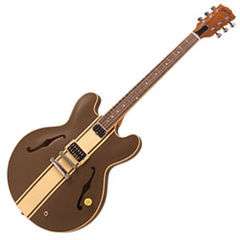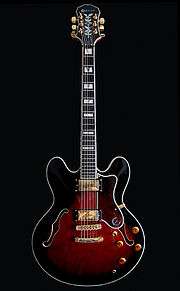Gibson ES-335
| Gibson ES-335 | |
|---|---|
 | |
| Manufacturer | Gibson |
| Period | 1958–present |
| Construction | |
| Body type | Semi-hollow |
| Neck joint | Set neck |
| Scale | 24.75 in (629 mm) |
| Woods | |
| Body |
Maple (plywood) Usually with maple center block |
| Neck | Usually mahogany |
| Fretboard |
Usually Rosewood Ebony |
| Hardware | |
| Bridge | Usually Tune-O-Matic with stopbar |
| Pickup(s) | Usually 2 humbuckers |
| Colors available | |
|
Various, often sunburst-type finishes Wine Red | |
The Gibson ES-335 is the world's first commercial thinline archtop semi-acoustic electric guitar. Released by the Gibson Guitar Corporation as part of its ES (Electric Spanish) series in 1958, it is neither hollow nor solid; instead, a solid maple wood block runs through the center of its body. The side "wings" are hollow, and the top has two violin-style f-holes over the hollow chambers.[1]
Origins
Before 1952 Gibson produced only hollow-body guitars, which are prone to feedback when amplified loudly. That year saw the introduction of their first solid-body, the Gibson Les Paul, a significantly different instrument from Les Paul's early electric guitar experiment, "The Log", which consists of a center block with detachable chambers on the both side,[2][3] a neck, hardware, and pickup attached. By 1958 Gibson was making a few solid-body models which had much lower feedback and better sustain but lacked the darker, warmer tone and unamplified volume of hollow bodies. The ES-335 was an attempt to find a middle ground: a warmer tone than a solid body with almost as little feedback. Though semi-hollow-bodies like the ES-335 are essentially a compromise of earlier designs, they are for this reason extremely flexible, as evidenced by the ES-335's popularity in a wide range of music, including blues, jazz, and rock. With a basic price of $267.50 it quickly became a best-seller, and has been in continuous production since 1958.
The first major update came in mid 1962, with the most visible change being the markers on neck: early models had dots (hence "dot neck"), later models had blocks.[4]
Models
Some models feature a coil split switch, which allows the humbuckers to produce a "single-coil" sound. The ES-335 Pro, ES-335TD CRS and CRR models were equipped with Gibson "Dirty Fingers" humbuckers, which had a significantly higher output than the standard pickups.
The company has produced a number of signature guitars as well, such as Trini Lopez-inspired model (1964-1970) with narrow diamond-shaped soundholes replacing the f-holes, a Firebird-style headstock with all the tuners on one side, and slashed-diamond inlays. In September 2007, Gibson introduced the DG-335, designed in collaboration with Dave Grohl, a variation on the Trini Lopez Gibson; the Grohl model has a stopbar tailpiece and Gibson's new Burstbucker humbuckers.[5] Other signature models include the heavily customized Alvin Lee "Big Red" 335. A reissue of the 1963 model was a 2014 "Editor's pick" in Guitar Player magazine, at $4000[4]
Variations
ES-345

The ES-345 was first produced in 1958 as upscale version of ES-335. Although the design is very similar to the 335, the 345 featured a multi-position "Varitone" switch located just above the lead tone and volume controls, which added various combinations of inductors and capacitors to the electronic pickup circuit of the guitar in order to alter its resonant frequency and add "color" to the sound. The ES-345 also featured an optional stereophonic output jack, gold-plated hardware, large split parallelogram fingerboard inlays (similar to ES 175), and a thicker three-ply edge binding than that of the ES-335. Notable users were B.B. King, Freddie King, Bill Nelson, John McLaughlin, Jorma Kaukonen, Fred Frith, Porl Thompson of The Cure and Elvin Bishop.
It was discontinued in 1981, one year after the Gibson Lucille was launched. As of 2012, the ES-345 is available as limited edition of Epiphone, as well as the ES-355. The differences between two models are:
- The headstock inlay on ES-345 is a "small crown", instead of a "split-diamond" custom inlay on the ES-355.
- The position markers on ES-345 are "double parallelogram", instead of the "block" inlays on the ES-355. Also, the first fret on the ES-345 is not inlaid.
- The stereo output wiring and the Varitone was factory-installed on the ES-345 and ES-355TD-SV, but not on the unmodified ES-355TD (mono version).
- The vibrato unit (Vibrola or Bigsby) was an option on the ES-345; In contrast, it was factory-installed on most ES-355s (except for the earlier models in the 1950s, final models after 1979,[6] and Lucille).
ES-355

The ES-355TD (Thinline semi-hollow, Double pickups) was at the top of Gibson's range of thinline semi-acoustic guitars. It was manufactured from 1958 until 1982,[7][8] fitted with Varitone Stereo option (SV), as ES-355TD-SV released in 1959.
The headstock has a split-diamond inlay rather than the smaller crown inlay on the 335/345, in addition to a multiple-layered binding. The fingerboard inlays are inlaid mother-of-pearl blocks, beginning at the first position of the fretboard. In addition to the headstock, binding is also applied to the fretboard and both the front and the back edges of the body. Rather than the rosewood fretboard on a 335 or 345, both variations of the 355 have an ebony fingerboard for a 'smoother' sound. Reissues use a richlite fingerboard. Early models of Epiphone's limited edition budget version had an ebony fingerboard but the later issues had a rosewood board.
The ES-355 was available with a Vibrola vibrato unit or a Bigsby vibrato tailpiece. It was also available with a stereo output and Varitone tone filter circuitry. When fitted with the optional stereo wiring and Varitone, the model was known as the ES-355TD-SV.
The best-known user of this guitar is probably B.B. King, whose trademark guitar, Lucille, was the basis for a 1981 signature model.[9] It has the optional stereo wiring and Varitone circuitry as standard.[10] It differs from the ES-355 by having a maple neck instead of mahogany, the name "Lucille" on the headstock, and the lack of an F-hole on its top.[11]
EB-2 & EB-2D
The EB-2 was first produced in 1958 as the bass version of the ES-335. Having the same body as the ES-335, it held a 30.5" scale neck and hardware borrowed directly from the Gibson EB-0. In 1959, a "baritone-switch" was added to filter the output from the neck humbucker and give it more of a guitar-like sound. The EB-2 was discontinued at the end of 1961, being replaced by the EB-3.[12] Due to a boom in the use of the EB-2 and its sibling, the Epiphone Rivoli, in the Merseybeat in England in the early sixties, production restarted in 1964, with a 2-pickup version called the EB-2D being added to the line in 1966. In 1972 the EB-2 line was discontinued.[13]
CS Series
The CS-336 is a smaller version of the ES-335. The back and sides of this guitar are constructed from a single piece of carved mahogany, and its reduced size is closer to that of the Les Paul. Also available, the CS-356 has gold-plated hardware and multiple binding on the body, neck and headstock. In 2007, Gibson introduced the ES-339 with the size of the CS-336 and the laminate construction of the ES-335.
Other
Other models based on the 335 include the ES-333, the ES-340 (the toggle switch has settings of the pickups in-phase, pickups out-of-phase and standby), the ES-347 (includes a coil tap, block markers on an ebony fretboard, fine tuning tailpiece and, on earlier models, a brass nut, and a greater sustain block), the ES-339, essentially a 335 with the body reduced to Les Paul size; and the Gibson Les Paul signature bass.
Although the ES-330 resembles the 335, it is actually fully hollow (as opposed to semi-hollow) and features two P-90 pickups (as opposed to 2 humbucking pickups), and was designed as the successor of the Gibson ES-225.
Epiphone
Gibson also markets a much less expensive version of the ES-335 under its Epiphone brand, called the Dot (referring to its dot-style inlay). Other Epiphone semi-hollowbody style models include the Sheraton (a fancier version of the co-developed ES-335, released the same week, it can make equal claim as the first semi-hollowbody), the Riviera, and the Dot Studio, though some of those are modeled after other guitars in the ES series.
From 1958 until 1970, Epiphone guitars were produced in Gibson's Kalamazoo, MI factory, and shared the similar design, materials and electronics as their Gibson counterparts. The Riviera, Sheraton, Rivoli and Newport models shared similarities with the Gibson ES-335, EB-2 and EB-0 models, respectively. In 1970, Epiphone production ceased in the Kalamazoo plants and Epiphones were made at the Matsumoku factory in Japan. Later Epiphones were constructed under contract with Samick in Korea. These early Epiphones are generally thought to be of good quality. Since 2002 almost all Epiphones are made in the 'Gibson' QingDao plant in China.[14]
As of 2012 Epiphone also produces the ES-335 PRO, ES-339 PRO, ES-345 Stereo, ES-355, and the Lucille.
See also
References
- ↑ "1959 ES-335 Dot Reissue", Gibson Guitar Corp. Retrieved 2011-06-28.
- ↑ Bacon, Tony (2012). The Ultimate Guitar Sourcebook. MBI Publishing Company. p. 83. ISBN 978-1-61058-842-3.
The “log” is the solid pine block that Les used to create the center block of the body, with “wings” of an Epiphone body added to complete the shape.
- ↑ Carter, Walter (2007). The Gibson Electric Guitar Book: Seventy Years of Classic Guitars. Backbeat Books. p. 151. ISBN 978-0-87930-895-7.
The Log (2003) Replica of Les Paul's Log, 4 x 4-inch centerpiece • Solid 4 x 4-inch center block, detachable wings from full-depth archtop, ...
- 1 2 Guitar Player staff (June 2014). "Six Semi-Hollow Electrics". Guitar Player. pp. 89–101.
- ↑ "Gibson DG-335 Inspired by Dave Grohl, Released'. Electric Guitar Review, 2007-09-28.
- ↑ "Gibson ES-355 TDSV". Vintage Guitars. Retrieved 2011-01-23.
- ↑ "Gibson ES-355". Vintage Guitars. Retrieved 2011-01-23.
- ↑ Fjestad, Zachary R. (2007). "Gibson Electric Serialization" (PDF). Blue Book of Electric Guitars (11 ed.). Blue Book Publications, Inc. ASIN B001TJXCFQ.
- ↑ "Gibson Custom B.B. King Lucille". Gibson Guitar Company. Retrieved 2011-01-23.
- ↑ http://www.gibson.com/magazines/amplifier/1999/1/Ax.html
- ↑ Drozdowski, Ted (2010-09-16). "B.B. King and Lucille: A Love Story". Lifestyle. Gibson Guitar Company. Retrieved 2011-01-23.
- ↑ "25 most valuable basses". Retrieved 20 August 2012.
- ↑ "Gibson EB-2 & EB-2D". Retrieved 26 July 2012.
- ↑ "A-Chat-With-Epiphone-President-Jim-Rosenberg". Epiphone.com. Retrieved 2013-08-20.
External links
| Wikimedia Commons has media related to Gibson ES. |
- ES-335, from Gibson's website



.jpg)

